Ossett and its name.
There are many versions of where Ossett got its name.
The name was from around 870 or 880 AD.
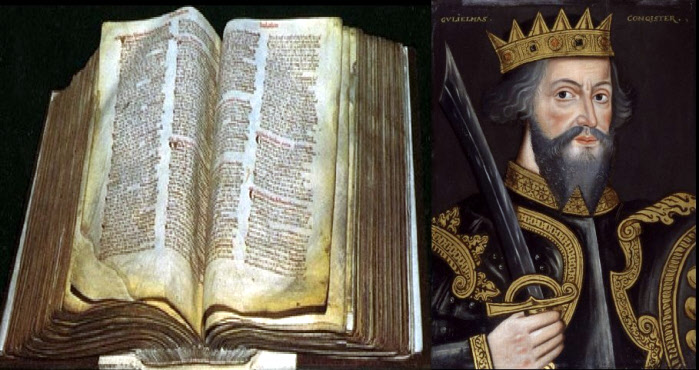
Above: The Domesday or Doomsday Book with a depiction of William the Conqueror.
Ossett was mentioned in the Domesday book as Osleset. 200 years later it became Ossete.
The likely meaning is that it was Osla was the name of a Chieftain (head of the village) and gave the name to his “sett”.
Makes sense doesn’t it? OS SETT?
Rachel Driver, April 2020
Prize Fighting in Ossett in the 1800s
This prize fighting included cock fighting, dog fighting and men bare knuckle fighting.
They were often held at the Bulls Head (pic 1 and 2, around where the dentist is) Cock & Bottle (still there) and the Hare & Hounds (pic 4 is where the Hare & Hounds used to stand, near to the yard of where Queen Street garage is now)
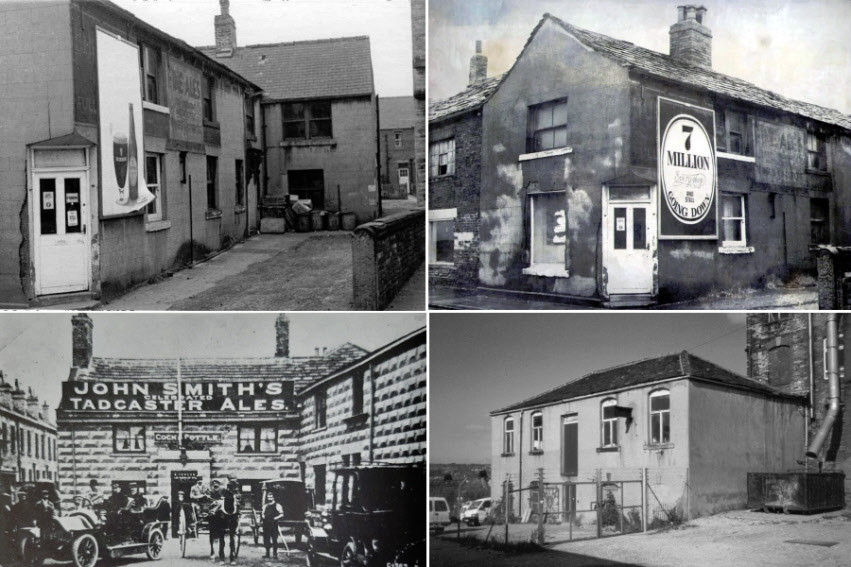
It was eventually made illegal but continued regardless. Albeit in secret.
Most people in the town who kept poultry, also kept a game cock for fighting purposes. Bulldogs were trained to fight. And fight to their deaths. Barbaric then and still is now. Although not something you would see in the Market Place today. Thankfully.
Bare fist fighting was popular with the patrons of the Hare & Hounds.
For those patrons who couldn’t read, they spent their Sunday morning, listening to the results of the fights read out for them in the pub.
The educated patrons were the ones who read it out from the “Bells Life”, a famous sporting journal that carried news and graphic descriptions of all the prize fights in the land.
I hate fighting of any description but it was very common back then.
Rachel Driver, April 2020
Ossett Baths
 Back in early 1800s, Ossett’s baths, later known as Cheltenham Sulphurous baths, gained a reputation as having an ability to help illnesses.
Back in early 1800s, Ossett’s baths, later known as Cheltenham Sulphurous baths, gained a reputation as having an ability to help illnesses.
It was said to help the relief in many ailments. Those included gout, rheumatism, scrofula (tuberculosis) and scorbutic complaints (scurvy).
These baths were often used by the people of Ossett. Only married couples were allowed to bathe together.
People living in Ossett Spa still collected water for their own consumption from these baths right up until the 1920s.
I think most of us now rely on traditional medicine, but good to know that our fellow Ossett folk could gain some pain relief in a time where there wasn’t much medicine available.
There is one of these baths left. Located on Spa Street.
Rachel Driver, April 2020
Ossett's Unofficial Coat of Arms
It has words and pictures on it. All which mean something. It’s often seen on Ossett keepsakes, like Jubilee mugs and postcards. 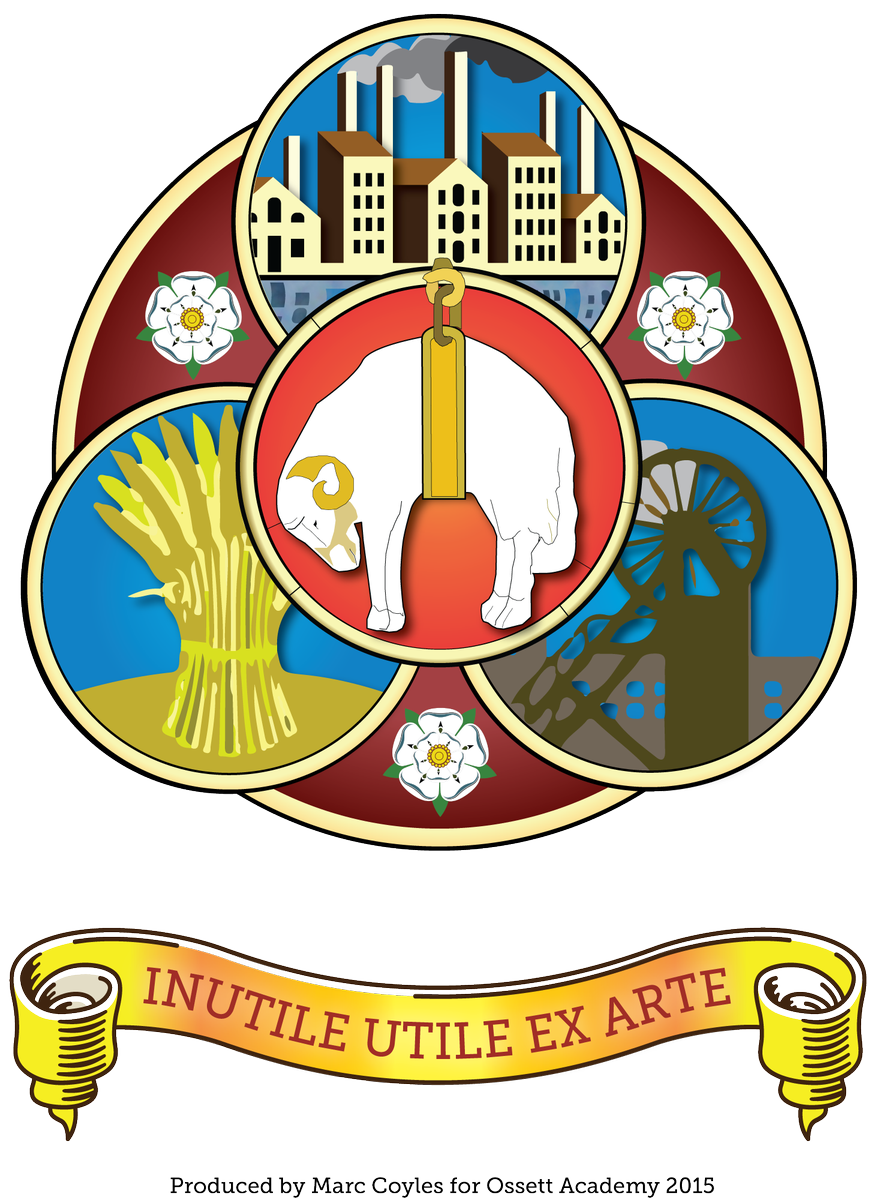
The design shows the three most important work places in the town at that time (around late 1800s). They were wool and shoddy mills (for fabric), coal mining and agriculture.
The sheep shows the importance of wool. The three white roses are a symbol of Yorkshire.
The writing is Latin. “Inutile utile ex arte”. This saying came from the Headmaster at Ossett Grammar School, Mr M Frankland. and means “useless things made useful by skill” .
For example, coal buried deep underground is “useless”. But, if a miner skilfully removes it and brings it to the surface, it could be used to heat their homes. Making it “useful”.
Rachel Driver, April 2020
Ossett Water and it's Wells
When you are thirsty and you get a lovely cold drink of water straight from the tap, do you realise it wasn’t always like that?
How would you have felt to have taken a bucket and walked to your nearest well? And no guarantee there would be any water. If there was, it was almost certainly filled with bacteria.
200 years ago Ossett was a very different place.
So much so, that beer was actually safer to drink than the water.
At that time, rubbish was thrown into the street and there was no drainage. Sewage ran through the open drains in front of the houses.
Can you imagine that? Poo outside your front door? Not nice at all. Together with the rubbish, the smell would have been awful.

Above: New Well, the main public well in the town was located near Wesley Street. It is pictured here in the 1970s during excavation work.
There were 25 wells in Ossett. All thanks to the above, filled with mostly polluted water. They had ash, decaying vegetables and sewage in them.
A lot more people died back then. Not helped when poisoned by the water.
By the early 1870s, a piped water supply and new sewage works were planned at a cost of £44,000. Not in time to stop this tragic accident though.
In 1875, Rachel Butterworth, age 27, who was already ill from drinking the polluted water, was sat on the edge of Green well, on Healey Lane. A piece of her clothing fell in and she went in to get it back. She drowned and her body was recovered 11 hours after she went missing.
A year after Rachel’s death, water was piped from Dewsbury to Gawthorpe reservoir but as Ossett grew over the years, it became clear there wasn’t enough water for us and another water source needed to be found.
In 1928, Pildacre Waterworks started pumping water from the old underground mine workings and it was sent to Gawthorpe Water Tower.
This dried up in 1974 and our water supply is now from Fixby, near Huddersfield.
Think of how many places in Ossett have “well” in their name?
For example, West Wells, Dimple Wells, Cavewell........
These will almost certainly have been near to one of the 25 wells around Ossett. Can you think of any more?
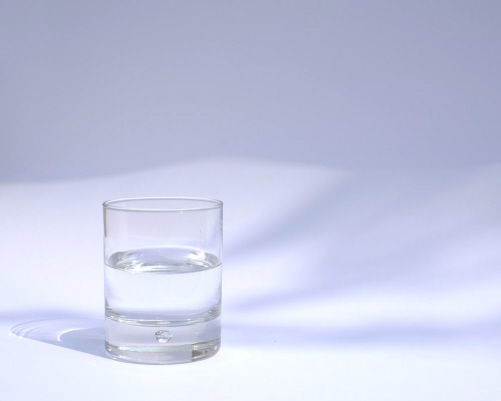
Next time you turn the tap on and see that clear cold water, be glad you aren’t going out with your bucket!
Rachel Driver, May 2020
Ossett Mining
Ossett had many pits. More than I knew about. There are records of twenty-six different coal mines in Ossett including Roundwood, which was one of the largest in the area.
In the 19th century and early 20th century, children were sent down the pits, some were as young as 10, and worked twelve hours a day. They performed the duty of “hurrier” and moved the coal that an older miner had mined to and from the coal face.
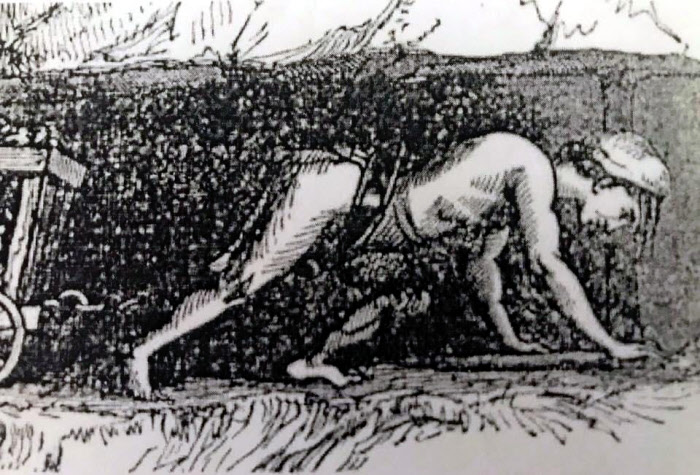
That already sounds bad. But could you imagine having to do that in a tunnel at some points only 16” in height? That’s about as high as the chair you sit on at school. Try getting under your chair. Not much room is there? They were often only guided by candlelight which held dangers of its own, with dangerous explosive gases ready to ignite at any time.
Health & Safety, which now keeps us safe, did not exist back then.
Younger children performed the task of “door keepers”. Some at only 6 years of age.
One girl, Mary Davies, was found by the Government Inspector, fast asleep against a stone. Her lamp had run out of oil. The rats had eaten her lunch. 6 years old!!! I can’t imagine how scared she must have felt. Can you? No light. Rats running around her. Alone.
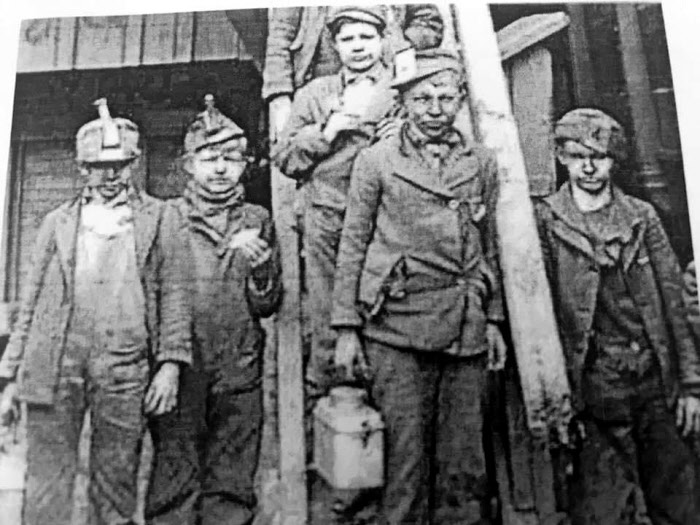
There were many accidents in the mines. Roof falls. Explosions. Carts running over the children. It was a dangerous job.
Eventually the coal began to run out, it became more expensive and the mines started to close.
Underneath Ossett there are many kilometres of abandoned mine works. Most were filled in with clay, soil and stones.
Would you have wanted to be a miner?
Rachel Driver, May 2020
Shoddy and Mungo
Shoddy and Mungo are both types of cloth, made from old rags mixed with some new wool.
Rag sorters had a very difficult job.
Usually women and girls were given the job. It was a dirty, smelly job which didn’t pay very well either.

Above: Rag pickers working on a pile of rags during WW1.
Shoddy.......
Bales of rags, usually dirty old clothes were imported from places like Poland, Germany and Denmark. These had to be sorted, piece by piece.
They were often infested with fleas and had to be disinfected. I wonder if the women sorting the rags got bitten much? Very probably.
After washing, they were put into shredding machines which ground the rags into fibres. They were then mixed with wool and woven into Shoddy.
Do you recognise that word? It’s sometimes used to describe something that isn’t very good. Shoddy was used to make blankets and army uniforms.
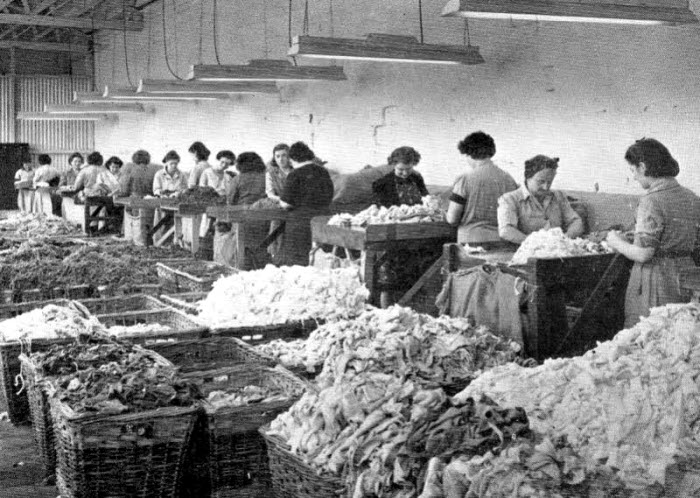
Above: Rag Sorters working at Victoria Mill, Ossett.
Mungo.......
Mungo was made in the same way as shoddy, but the rags were far better quality. These were tailors off cuts, coats, trousers, and hats too.
These were then shredded into fibres, and mixed with wool fibres and sometimes some cotton and linen. This, when woven, made a finer cloth.
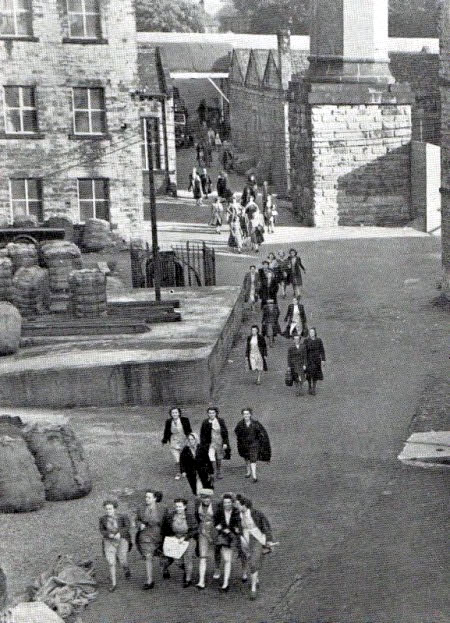
Above: Workers leaving Victoria Mill, Ossett with bales of rags shown on the left of the picture.
Sometimes, Ossett folk could take their old clothes directly to the mills and get paid for them. Sorting was done by quality and colour. And the sorters had to work very quickly, throwing them into the baskets surrounding them.
Rags that weren’t fit for any kind of recycling were left to rot and used as manure on the farmers fields around the town.
When grinding the rags, there was a fine dust that was created. This often caused the mill workers to suffer from “shoddy fever”. This caused Asthma, Bronchitis and lung problems too, when taken in whilst breathing.
In some rare cases, the dust contained anthrax bacteria, and breathing this in causes the heart to stop almost immediately.

Above: Power looms in a mill making cloth.
Thankfully, fabric manufacturers of today, have protective equipment to avoid any issues with regards to breathing and ear protection too.
Rachel Driver, May 2020
A Royal Visit
On July 10th 1912, King George and Queen Mary came to visit Ossett. They were headed for the Town Hall where the Mayor was waiting for them.
The Town Hall was decorated with lots of buntings, flags and streamers. It was quite a sight. These were the same decorations used at the opening of the Town Hall some 4 years before.

All the school children were given a small Union Jack to carry and wave at the Royal visitors.
The King and Queen travelled by car through Horbury and up Station Road. The route was lined with people all waving their flags. The houses on the main road all had big flags hanging out of their windows. The local scouts saluted them as they passed.
When they arrived at the Town Hall, there were people everywhere! Bands were playing. Everybody was excited to see the King and Queen.
Some men and boys had climbed high on to roofs to get a better view!
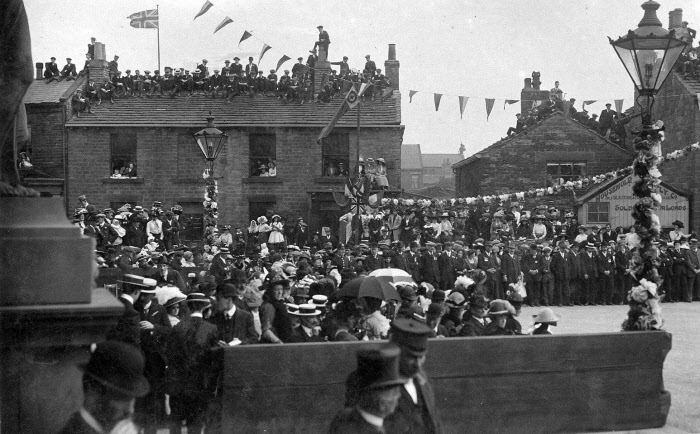
The visit was shorter than expected. When asked by the Mayor if they would like to see inside the Town Hall, the King replied that he had been told that they didn’t have time.
So, they climbed back into the car and set off for another visit. This time, to Dewsbury.
Rachel Driver, April 2020.
Palladium (Cinema)
Did you know Ossett had a cinema?

It was right in the centre of town near the Town Hall. The picture above by Julian Gallagher shows where the cinema once stood.
It opened in December 1913.
The first film was called “Greater love hath no man”. It had 846 seats.

It closed in March 1961 and was demolished a year later.
Would you like to have a cinema back in Ossett?
Rachel Driver, April 2020
Ossett Bombing
The Observer reported back on 21st September 1940 about several bombs being dropped on Ossett. The attack started with a piercing wail followed by a huge explosion.
 The first bomb was dropped in the cricket field and more followed as the plane flew over Ossett. At the time there was a meeting being held in the Town Hall. This was immediately stopped, they ran into the Market Place to see many people running out of the shops and cinema to get away from the explosions and to their homes.
The first bomb was dropped in the cricket field and more followed as the plane flew over Ossett. At the time there was a meeting being held in the Town Hall. This was immediately stopped, they ran into the Market Place to see many people running out of the shops and cinema to get away from the explosions and to their homes.
It would have been scary to see so much panic.
There were further explosions as people desperately looked for shelter. There were a few shelters but not all were finished! Some didn’t have a roof. That wasn’t a good place to shelter. But there were some completed shelters on Southdale fields and lots of people took cover there. Questions would be asked later about the incomplete shelters.
Lots of adults and children ran to their cellars for safety. Can you imagine hearing the bombing plane above you, plaster coming off your walls and your windows breaking? Must have been very frightening. Do you have a cellar?
One bomb went off in a garden where two 8 year old boys were playing. One was thrown into an open bin. One was thrown over the wall by the blast. Both escaped with bruises but also suffered with shock.
One bomb was dropped very near Southdale School. Poultry huts were hit and over a 100 chickens were killed.
 A woman was walking with a baby in a pram on the path on Station Road. When she heard the aircraft, she took her baby out of the pram, placed it against the wall, covered it with a pillow and lay down beside it to protect her baby. When the danger had passed she simply placed her baby back in the pram and carried on walking.
A woman was walking with a baby in a pram on the path on Station Road. When she heard the aircraft, she took her baby out of the pram, placed it against the wall, covered it with a pillow and lay down beside it to protect her baby. When the danger had passed she simply placed her baby back in the pram and carried on walking.
Lots of people had to be moved out of their homes to make sure they were safe to live in. There was lots of damage, windows broken, gardens destroyed. But thankfully, no direct hits to any homes, buildings or people. The picture on the right is Mona Cottage, that had windows blown out.
It is said the people of the town all pulled together and helped each other as best they could.
This was probably a random attack on Ossett. At first, it was understood that it could have been two planes but it was decided it was just the one plane which dropped between 20-30 bombs.
Our town was lucky that day.
Rachel Driver, April 2020
Ossett Population
Ossett has had a steady growth in population since the year 1750.
I’ve not listed them all, but this should give you an idea . . . . .
Year |
Population |
1750 |
2,000 |
1821 |
4,775 |
1841 |
6,077 |
1861 |
7,950 |
1881 |
10,952 |
1950 |
14,000 |
1971 |
17,000 |
2011 |
21,231 |
How many people do you think will be recorded as living in Ossett at the next count, which is in 2021?
Rachel Driver, April 2020
